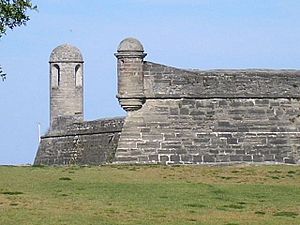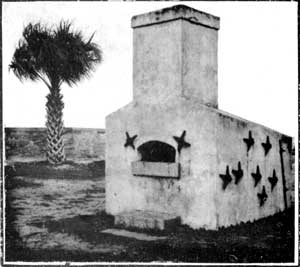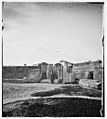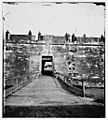Castillo de San Marcos facts for kids
|
Castillo de San Marcos National Monument
|
|
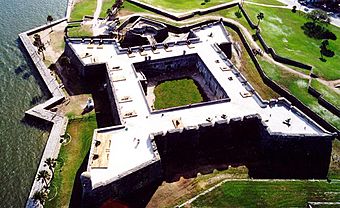
Aerial view of Castillo De San Marcos
|
|
| Location | 11 South Castillo Drive St. Augustine, Florida |
|---|---|
| Area | 20.48 acres (82879.62 m2) |
| Built | 1672–1695 |
| Visitation | 624,841 (2022) |
| Website | Castillo de San Marcos National Monument |
| Part of | St. Augustine Town Plan Historic District (ID70000847) |
| NRHP reference No. | 66000062 |
Quick facts for kids Significant dates |
|
| Added to NRHP | October 15, 1966 |
| Designated NMON | October 15, 1924 |
The Castillo de San Marcos is the oldest masonry fort in the continental United States. Its name means "St. Mark's Castle" in Spanish. You can find it on the western shore of Matanzas Bay in St. Augustine, Florida.
Spanish engineers designed this amazing fort. Construction began in 1672, more than 100 years after St. Augustine was founded. The fort was needed to protect the city after an English pirate attack in 1668. The main part of the fort was finished in 1695.
Over the years, the fort changed hands five times without a single battle. It was controlled by Spain, Great Britain, and the United States. During the American Civil War, it was briefly held by the Confederate States of America.
The fort was renamed Fort St. Mark by the British and later Fort Marion by the Americans. In 1942, its original Spanish name, Castillo de San Marcos, was restored. Today, it's a National Monument and a popular place to visit.
Building the Fort
The city of St. Augustine was founded by the Spanish in 1565. For many years, the city was protected by wooden forts. But these forts were not strong enough. After a pirate attack burned the town in 1668, Spain decided to build a much stronger stone fort.
What is Coquina Stone?
The Castillo is a masonry star fort made from a special stone called coquina. This Spanish word means "small shells." Coquina is a sedimentary rock made of ancient shells that have bonded together. It's similar to limestone.
Native Americans from nearby Spanish missions did most of the hard work. Skilled builders from Havana, Cuba, also helped. The coquina stone came from the 'King's Quarry' on Anastasia Island. Workers ferried the stone across Matanzas Bay to the construction site.
Fort Design for Defense
The fort has four main corners called bastions. These are named San Pedro, San Agustín, San Carlos, and San Pablo. A special outer wall, called a ravelin, protected the main entrance, known as the sally port.
On the land sides, a large sloping area called a glacis was built. This made it harder for attackers to reach the fort. It also helped the fort's cannons hit targets more easily. A moat surrounded the fort. It was usually dry but could be filled with seawater during an attack.
The coquina stone walls were very effective against cannonballs. Instead of shattering, the cannonballs would often sink into the soft, shell-filled stone. This made the fort incredibly difficult to breach.
Fort's History
First English Attack (1702)
In 1702, English forces from Carolina attacked St. Augustine. About 1,500 people from the town and soldiers took shelter inside the Castillo. The English cannons fired for two months, but the coquina walls held strong. The cannonballs just sank into the stone.
The siege ended when Spanish ships arrived from Havana. The English had to burn their own ships and march back to Carolina. St. Augustine was badly damaged, but the fort was never captured.
Fort Upgrades
After the first siege, the fort was made even stronger. Starting in 1738, Spanish engineers redesigned the inside. They made rooms deeper and added strong vaulted ceilings. These new ceilings protected better from bombs. They also allowed more cannons to be placed along the top of the fort. The outer walls were made taller, too.
Second British Attack (1740)
Spain and Britain were often rivals. In 1739, a conflict known as the War of Jenkins' Ear began. In 1740, General James Oglethorpe from the British colony of Georgia attacked St. Augustine.
Again, hundreds of soldiers and residents found safety inside the Castillo. For 27 days, the British bombarded the fort. But just like before, the coquina walls absorbed the cannon fire. Oglethorpe tried to starve the people by blocking the Matanzas River. However, some supplies still reached the city. With their own supplies running low, the British had to retreat. To prevent future blockades, the Spanish later built Fort Matanzas to guard the river entrance.
British Takes Over (1763-1783)
In 1763, Britain gained control of the Castillo, but not by fighting. After the Seven Years' War, Spain gave Florida to Britain in exchange for Havana. The fort was renamed Fort St. Mark.
During the American Revolutionary War, the British used the fort as a military prison. Important American leaders, like Christopher Gadsden, were held there. The British also made some improvements to the fort, repairing walls and adding second floors to rooms.
At the end of the war in 1783, Florida was returned to Spain.
Back to Spain (1783-1821)
When Spain got Florida back, they changed the fort's name back to Castillo de San Marcos. They continued to improve the fort. However, due to pressure from the new United States, Spain eventually sold Florida to the U.S. in 1819. The transfer happened in 1821.
First United States Control (1821-1861)
The Americans renamed the fort Fort Marion to honor American Revolutionary War hero Francis Marion. They made few structural changes. Many storage rooms became prison cells. Part of the moat was filled in to create a new artillery battery. A special furnace was built to heat cannonballs. These "hotshots" could set wooden enemy ships on fire.
During the Second Seminole War, Seminole chief Osceola was captured and imprisoned at Fort Marion in 1837. Other Seminole leaders, including Coacoochee, were also held there. In November 1837, Coacoochee and nineteen other Seminole prisoners famously escaped from the fort. They reportedly squeezed through a small opening in their cell and slid down a rope into the dry moat.
Civil War Period (1861-1862)
In 1861, Florida left the United States at the start of the American Civil War. Confederate soldiers took control of Fort Marion without a fight. Most of the fort's cannons were sent to other important forts.
In March 1862, Union troops arrived by ship. The city leaders surrendered St. Augustine and the fort peacefully. The Confederate forces had already left.
Second United States Control (1862-1900)

After the Civil War, the fort continued to be used as a military prison. From 1875 onwards, many Native American prisoners were held here after conflicts in the west. These included chiefs like White Horse of the Kiowa and Grey Beard of the Cheyenne.
A Civil War veteran named Richard Henry Pratt was in charge of the prisoners. He improved their conditions, removing shackles and allowing them out of their cells. He started educational programs, teaching them English and other skills. Many prisoners created beautiful Ledger Art drawings, some of which are now in the Smithsonian Institution.
Pratt's work at Fort Marion led him to create American Indian boarding schools. The most famous was the Carlisle Indian Industrial School.
From 1886 to 1887, about 491 Apache people were held at the fort. This group included women and children, and members of Geronimo's band. Many prisoners had to live in tents because there wasn't enough space inside. At least 24 Apache prisoners died and were buried nearby.
In 1898, the fort held over 200 deserters from the Spanish–American War. This was one of the last times the fort was actively used by the military. In 1900, after 205 years of service, the fort was officially taken off active duty.
Preserving the Fort
In 1924, Fort Marion was named a National Monument. In 1933, it was given to the National Park Service to manage. In 1942, Congress officially changed its name back to Castillo de San Marcos to honor its Spanish heritage.
In 1964, the Castillo played a role in the Civil Rights Movement. A "Freedom Tree" on the fort's green became a meeting place for peaceful demonstrators. These demonstrations in St. Augustine helped lead to the Civil Rights Act of 1964.
Today, the Castillo de San Marcos is a popular tourist attraction. It covers about 2.5 acres in downtown St. Augustine, Florida. The National Park Service takes care of it, along with Fort Matanzas National Monument.
Images for kids
-
Howling Wolf, of the southern Cheyenne, photographed while imprisoned at Fort Marion
See also
 In Spanish: Castillo de San Marcos (Florida) para niños
In Spanish: Castillo de San Marcos (Florida) para niños





